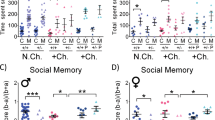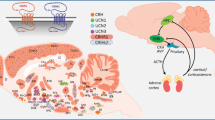Abstract
Patients with Alzheimer’s disease (AD) exhibit alterations in glucose metabolism and dysregulation of the stress-responsive hypothalamic-pituitary-adrenal (HPA) neuroendocrine system. The mechanisms responsible for these alterations and their possible contributions to the neurodegenerative process in AD are unknown. We now report that transgenic mice expressing a mutant form of human amyloid precursor protein (APP) that causes inherited early-onset AD exhibit increased sensitivity to physiological stressors, which is associated with aberrancies in HPA function and regulation of blood glucose levels. Specifically, APP mutant mice exhibit severe hypoglycemia and death following food restriction, and sustained elevations of plasma glucocorticoid levels and hypoglycemia following restraint stress. The alterations in HPA function and glucose regulation were evident in relatively young mice prior to overt deposition of amyloid β-peptide (Aβ). However, diffuse accumulations of Aβ were present in the hypothalamus of older mice, suggesting a role for soluble forms of Aβ in dysregulation of HPA function. Our data demonstrate disturbances in neuroendocrine function in APP mutant mice similar to those seen in AD patients. These impairments in stress response, glucocorticoid signaling, and regulation of blood glucose should be considered in interpretations of data from past and future studies of APP mutant mice.
Similar content being viewed by others
References
Ando Y., Brannstrom T., Uchida K., Nyhlin N., Nasman B., Suhr O., et al. (1998) Histochemical detection of 4-hydroxynonenal protein in Alzheimer amyloid. J. Neurol. Sci. 156, 172–176.
Bruce-Keller A. J., Umberger G., McFall R., and Mattson M. P. (1999) Food restriction reduces brain damage and improves behavioral outcome following excitotoxic and metabolic insults. Ann. Neurol. 45, 8–15.
Chapman P. F., White G. L., Jones M. W., Cooper-Blacketer D., Marshall V. J., Irizarry M., et al. (1999) Impaired synaptic plasticity and learning in aged amyloid precursor protein transgenic mice. Nat. Neurosci. 2, 271–276.
Cheng B. and Mattson M. P. (1992) Glucose deprivation elicits neurofibrillary tangle-like antigenic changes in hippocampal neurons: Prevention by NGF and bFGF. Exp. Neurol. 117, 114–123.
Duan W. and Mattson M. P. (1999) Dietary restriction and 2-deoxyglucose administration improve behavioral outcome and reduce degeneration of dopaminergic neurons in models of Parkinson’s disease. J. Neurosci. Res. 57, 185–206.
Gros L., Virsolvy A., Salazar G., Bataille D., and Blache P. (1999) Characterization of low-affinity binding sites for glibenclamide on the Kir6.2 subunit of the β-cell KATP channel. Biochem. Biophys. Res. Commun. 257, 766–770.
Hatzinger M., Z’Brun A., Hemmeter U., Seifritz E., Baumann F., Holsboer-Trachsler E., et al. (1995) Hypothalamic-pituitary-adrenal system function in patients with Alzheimer’s disease. Neurobiol. Aging 16, 205–209.
Hsiao K., Chapman P., Nilsen S., Eckman C., Harigaya Y., Younkin S., et al. (1996) Correlative memory deficits, Aβ elevation, and amyloid plaques in transgenic mice. Science 274, 99–102.
Lambert M. P., Barlow A. K., Chromy B. A., Edwards C., Freed R., Liosatos M., et al. (1998) Diffusible, nonfibrillar ligands derived from Abeta1–42 are potent central nervous system neurotoxins. Proc. Natl. Acad. Sci. USA 95, 6448–6453.
Leakey J. E., Chen S., Manjgaladze M., Turturro A., Duffy P. H., Pipkin J. L., et al. (1994) Role of glucocorticoids and “caloric stress” in modulating the effects of caloric restriction in rodents. Ann. NY Acad. Sci. 719, 171–194.
Mattson M. P., Cheng B., Davis D., Bryant K., Lieberburg I., and Rydel R. E. (1992) β-amyloid peptides destabilize calcium homeostasis and render human cortical neurons vulnerable to excitotoxicity. J. Neurosci. 12, 376–389.
Nasman B., Olsson T., Fagerlund M., Eriksson S., Viitanen M., and Carlstrom K. (1996) Blunted adrenocorticotropin and increased adrenal steroid response to human corticotropin-releasing hormone in Alzheimer’s disease. Biol. Psychiatry 39, 311–318.
O’Brien J. T., Schweitzer I., Ames D., Mastwyk M., and Colman P. (1994) The function of the hypothalamic-pituitary-adrenal axis in Alzheimer’s disease. Response to insulin hypoglycaemia. Br. J. Psychiatry 165, 650–657.
O’Brien J. T., Ames D., Schweitzer I., Mastwyk M., and Colman P. (1996) Enhanced adrenal sensitivity to adrenocorticotrophic hormone (ACTH) is evidence of HPA axis hyperactivity in Alzheimer’s disease. Psychol. Med. 26, 7–14.
Pedersen W. A., Fu W., Keller J. N., Markesberry W. R., Appel S., Smith R. G., et al. (1998) Protein modification by the lipid peroxidation product 4-Hydroxynonenal in the spinal cords of amyotrophic lateral sclerosis patients. Ann. Neurol. 44, 819–824.
Raber J. (1998) Detrimental effects of chronic hypothalamic-pituitary-adrenal axis activation. From obesity to memory deficits. Mol. Neurobiol. 18, 1–22.
Reisberg B., Borenstein J., Salob S. P., Ferris S. H., Franssen E., and Georgotas A. (1987) Behavioral symptoms in Alzheimer’s disease: phenomenology and treatment. J. Clin. Psychiatry 48, Suppl., 9–15.
Sayre L. M., Zelasko D. A., Harris P. L., Perry G., Salomon R. G., and Smith M. A. J. (1997) 4-Hydroxynonenal-derived advanced lipid peroxidation end products are increased in Alzheimer’s disease. Neurochemistry 68, 2092–2097.
Smith-Swintosky V. L., Pettigrew L. C., Sapolsky R. M., Phares C., Craddock S. D., Brooke S. M., et al. (1996) Metyrapone, an inhibitor of glucocorticoid production, reduces brain injury induced by focal and global ischemia and seizures. J. Cereb. Blood Flow Metab. 16, 585–598.
Stein-Behrens B. A. and Sapolsky R. M. (1992) Stress, glucocorticoids, and aging. Aging Clin. Exp. Res. 4, 197–210.
Stewart J., Meaney M. J., Aitken D., Jensen L., and Kalant N. (1988) The effects of acute and life-long food restriction on basal and stress-induced serum corticosterone levels in young and aged rats. Endocrinology 123, 1934–1941.
Stopa E. G., Volicer L., Kuo-Leblanc V., Harper D., Lathi D., Tate B., et al. (1999) Pathologic evaluation of the human suprachiasmatic nucleus in severe dementia. J Neuropathol. Exp. Neurol. 58, 29–39.
van de Nes J. A., Kamphorst W., Ravid R., and Swaab D. F. (1998) Comparison of beta-protein/A4 deposits and Alz-50-stained cytoskeletal changes in the hypothalamus and adjoining areas of Alzheimer’s disease patients: amorphic plaques and cytoskeletal changes occur independently. Acta Neuropathol. 96, 129–138.
Weiner M. F., Vobach S., Olsson K., Svetlik D., and Risser R. C. (1997) Cortisol secretion and Alzheimer’s disease progression. Biol. Psychiatry 42, 1030–1038.
Author information
Authors and Affiliations
Corresponding author
Additional information
These authors contributed equally to this work
Rights and permissions
About this article
Cite this article
Pedersen, W.A., Culmsee, C., Ziegler, D. et al. Aberrant stress response associated with severe hypoglycemia in a transgenic mouse model of Alzheimer’s disease. J Mol Neurosci 13, 159–165 (1999). https://doi.org/10.1385/JMN:13:1-2:159
Issue Date:
DOI: https://doi.org/10.1385/JMN:13:1-2:159




